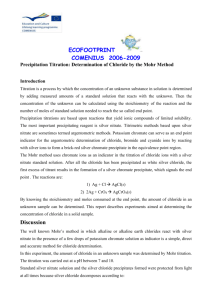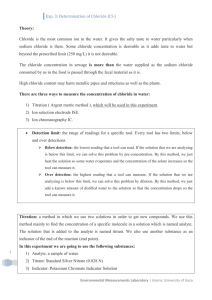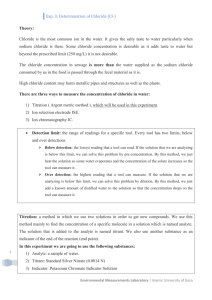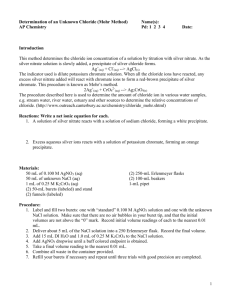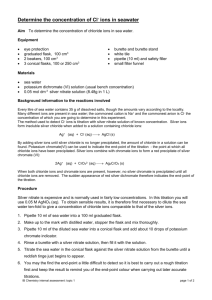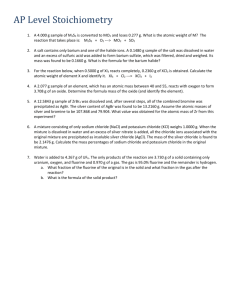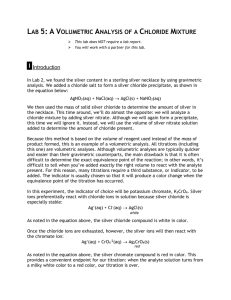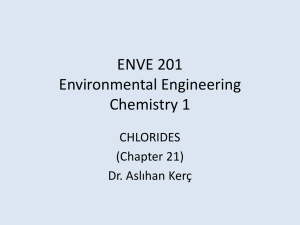Investigating silver nitrate titrations
advertisement
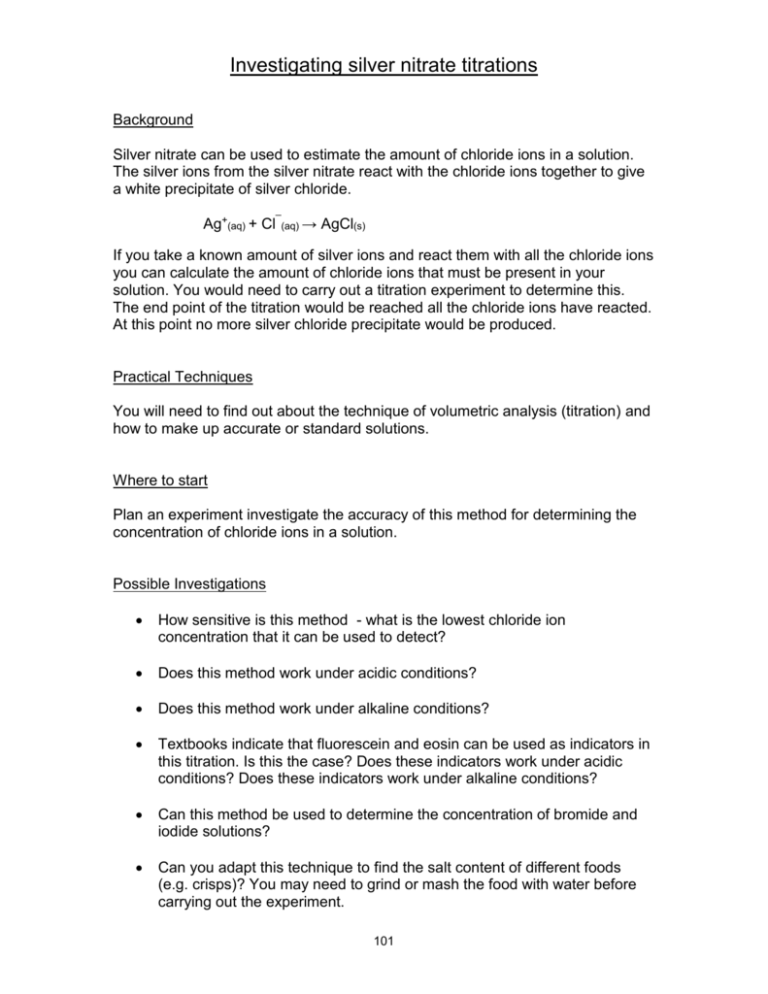
Investigating silver nitrate titrations Background Silver nitrate can be used to estimate the amount of chloride ions in a solution. The silver ions from the silver nitrate react with the chloride ions together to give a white precipitate of silver chloride. Ag+(aq) + Cl¯(aq) → AgCl(s) If you take a known amount of silver ions and react them with all the chloride ions you can calculate the amount of chloride ions that must be present in your solution. You would need to carry out a titration experiment to determine this. The end point of the titration would be reached all the chloride ions have reacted. At this point no more silver chloride precipitate would be produced. Practical Techniques You will need to find out about the technique of volumetric analysis (titration) and how to make up accurate or standard solutions. Where to start Plan an experiment investigate the accuracy of this method for determining the concentration of chloride ions in a solution. Possible Investigations How sensitive is this method - what is the lowest chloride ion concentration that it can be used to detect? Does this method work under acidic conditions? Does this method work under alkaline conditions? Textbooks indicate that fluorescein and eosin can be used as indicators in this titration. Is this the case? Does these indicators work under acidic conditions? Does these indicators work under alkaline conditions? Can this method be used to determine the concentration of bromide and iodide solutions? Can you adapt this technique to find the salt content of different foods (e.g. crisps)? You may need to grind or mash the food with water before carrying out the experiment. 101 Sources of Information Hill G.C. and Holman J.S. (1995) Chemistry in Context Laboratory Manual and Study Guide, Thomas Nelson Lainchbury A., Stephens J. and Thompson A. (1997) Advanced Practical Chemistry, John Murray The Chemistry Video Consortium and The Royal Society of Chemistry (2000) Practical Chemistry for Schools and Colleges CD ROM Ferguson M., Volumetric Analysis, Chemistry Review, Sept 1996 Woods G., Chlorides, Chemistry Review, Sept 1997 Thorpe A., Making a standard solution, Chemistry Review, November 2002 Battye P., Titrations, Chemistry Review, February 2003 http://www.rod.beavon.clara.net/chloride.htm Thorpe A., Assessing the risks in practical work, Chemistry Review, September 2000 Thorpe A., Experimental error and error analysis: just how good are those results, Chemistry Review, November 2001 102 Teachers' Notes General This investigation is largely based around the accuracy of the titration technique. Students can be encouraged to carry out the titration initially without the indicator as they can then see for themselves how difficult it is to determine the endpoint. They would then see the purpose of using an indicator. The potassium chromate indicator will not be effective under acidic or alkaline conditions. Chemical Principles Volumetric Analysis, halide ions Essential Equipment Burette, pipette, volumetric flasks Essential Chemicals Silver nitrate, sodium chloride, potassium chromate (VI) Timing Data can be obtained relatively quickly and many students will be able to carry out a large number of experiments. Safety No risk assessment has been given. It is essential that students prepare a detailed risk assessment before they start. Teachers must be satisfied that this is suitable for the proposed investigation. 103 Starter Experiment - Investigating silver nitrate titrations You should make up an accurate and known solution of chloride ions and titrate this solution with silver nitrate solution. You can make the chloride ion solution using sodium chloride and choose a concentration between 0.05 mol dm-3 and 0.1 mol dm-3. You should make the silver nitrate solution a similar concentration to the chloride ion solution. You should place the silver nitrate solution in the burette and titrate it against the chloride ion solution. This end point is difficult to determine, and in practice it is convenient to use an indicator to determine the end point. An indicator that could be used is potassium chromate(VI). Silver ions can combine with chromate(VI) ions to produce a red precipitate of silver chromate(VI). 2Ag+(aq) + CrO42- (aq) → Ag2CrO4 (s) red ppt When both chloride and chromate ions are present the white silver chloride appears first. When all the chloride ions have reacted, the chromate ions then react and a red precipitate will appear. So the sudden appearance of the red silver chromate can be used to indicate the end point of the titration. Make up a 5% or 0.1 mol dm-3 solution of the indicator and repeat the titration using the indicator. Add the indicator to the chloride solution. 104

